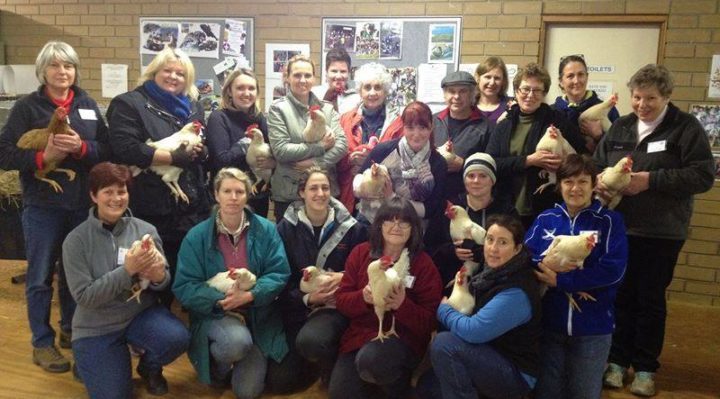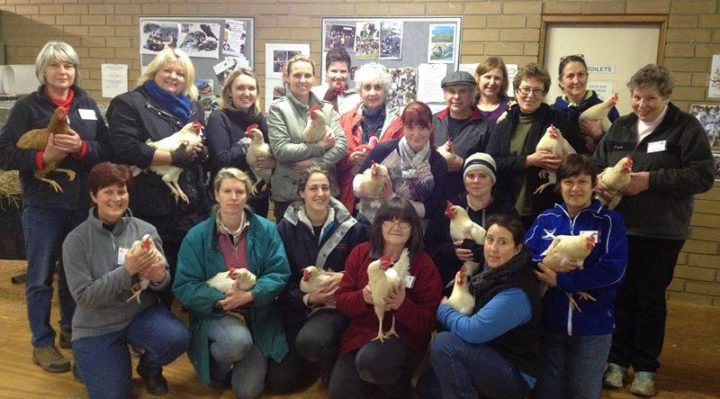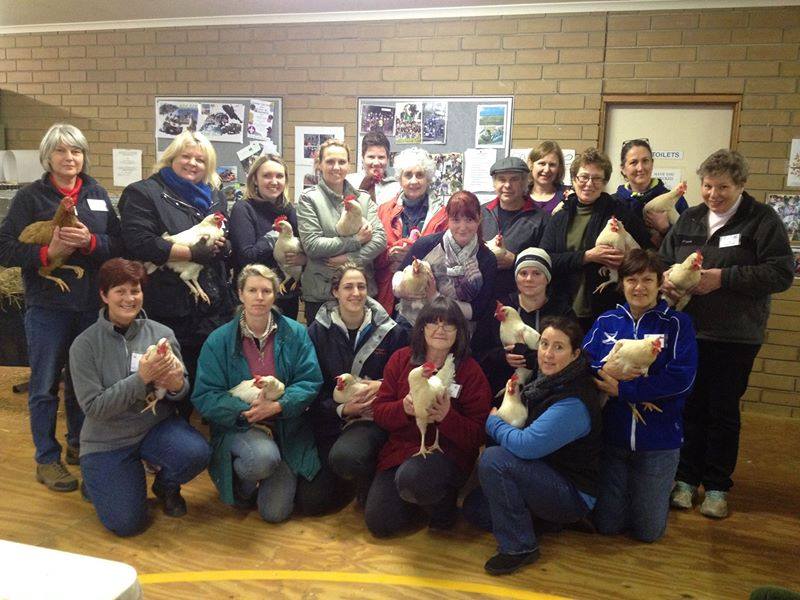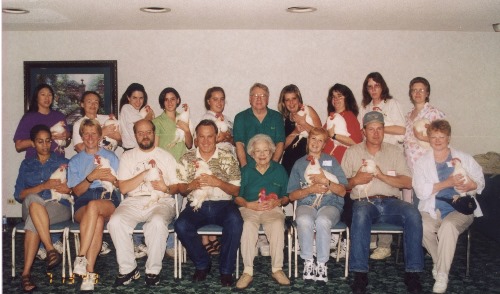


Last week, while I was preparing my blog about Terry Ryan’s virtual online chicken-training camps, I asked Facebook friends who are dog trainers and animal professionals if they would answer these two questions: “Have you attended a chicken-training camp? What did you learn about training there?” I added: “What camps did you attend, where, and who were the instructors? What insights did training chickens add to your knowledge of training in general? Why would you recommend a chicken-training camp or class to anyone who’s interested in learning more about training in general?”
Monique Feyrecilde (Washington) Chicken camp is the best!
Chickens are a fantastic model because they acquire and abandon behaviors quickly, and there are no emotional or long-term goal “strings” attached during camp. Those strings, I think, can make training harder to learn at times because of assumptions and baggage in the relationship between a person and their own animal. Chicken training allows students to focus on excellent mechanics with direct coaching in the moment. A gift for any trainer.
All chicken workshops I’ve been part of were held by Terry Ryan.
Geralynn Cada (Kansas) That chickens are easier to train than humans.
Janet Galante (Arizona) I learned how pathetically poor my mechanical skills were. Chicken camp is like a trainer’s come-to-Jesus meeting.
Susan Davies-Wright (California) I learned to get out of my head—had to be very sensitive to get results.
Donna Wilson Wolff (Illinois) I attended three weeks with Bob Bailey and Parvene Farhoody. Although I had years of training and theory education behind me, I learned how slow my mechanics were and the relationship of that to my training outcomes. Training birds requires much better timing and, when I came home to my dogs, I immediately saw how improved my skills with them were.
Debra Millikan (South Australia) I learned how easy dogs are to train and how forgiving they are. Chickens are not forgiving of timing errors. They are very fast and they allow you to see just how often errors are your fault. Thank you, chickens.


Photo provided by Debra Millikan
Sherry Al-Mufti (California) Years ago, Jacques and I travelled to Sweden to attend all five Bob Bailey chicken workshops (they were no longer called camps by then). Two years later, we attended two of the workshops for a second time, this time in Maryland with Bob and Parvene Farhoody.
Where to begin? Clicker/mechanical skills, for sure. Chickens are very demanding when it comes to mechanics and timing. One mistake can be quite costly. And lots of new concepts and ideas. Also, that a good training partner is worth their weight in gold, and a bad one can make your life miserable. I had good, bad, and decent partners, and it made a huge difference.
One of the very valuable things I learned and that I apply with my clients is that if you are teaching something involving distance, then distance is the last thing you should build. Get the behavior (stay, recall, retrieve, go around an object, target, etc., etc.) absolutely solid at close range before increasing distance.
When teaching stay, I have my clients work on duration standing very close to the dog, then work on distractions standing no farther than two steps away. When the stay is absolutely solid with strong distractions at two steps, then gradually start increasing the distance. Each time you increase the distance, back off on the intensity of the distractions and build back up, then increase distance again. Working this way produces a very solid, reliable behavior at a distance. It actually saves time because once the behavior is solid close in, increasing the distance can go pretty fast. It also means you will not have to keep going back and fixing the behavior.
Don Hanson (Maine) I attended two of the original chicken camps with Bob and Marian Bailey in Hot Springs, Arkansas. These two incredibly knowledgeable, passionate, yet very humble teachers were instrumental in developing my knowledge and skills as a professional animal trainer and as an instructor of people.
They emphasized the importance of the fundamentals: understand the normal behaviors of your subject; training is a mechanical skill; the importance of timing, criteria, and rate of reinforcement; training is simple but not easy, and is most effective when planned and executed scientifically and not done by the seat of your pants; and animals can be trained to reliably perform complex behaviors exclusively with positive reinforcement. Learning how to train a chicken helped me become better at training dogs and teaching their people.


Photo provided by Don Hanson
Sarah Richardson (California) I attended three weeks of chicken camp—beginning, intermediate, and advanced—with Bob and Marion Bailey in Hot Springs, Arkansas, in 2000. It was one of the most educational experiences of my professional life. I learned so much about training, chickens, people, and myself while there.
Among the many lessons, I learned to be aware of ALL the factors that might influence behavior during a training session . . . besides just reinforcement.
What happened to make this crystal-clear to me? One of our final exercises included teaching our chickens to walk up a plank to a platform, the first behavior in a rather lengthy behavior chain. My chicken mastered this task easily thanks to shaping and reinforcement. Because all subsequent behaviors in the chain depended on this initial one, we practiced it over and over again. It began with my placing the chicken at the bottom of the plank, her walking up the plank at a brisk pace, my reinforcing her for successful behavior with her chicken feed, then my picking her up to reposition her at the bottom again.
While we got off to a good start, as the week went on, my chicken began to walk more and more slowly up the plank until finally she flat-out refused to take the last few steps to the platform. I was reinforcing amply but my chicken’s behavior wasn’t getting stronger, faster, or better and in fact was deteriorating. I was stumped, so sought help from Bob who watched me training with my reluctant chicken. He pointed out the problem.
My chicken’s behavior (her refusal to take those last few steps and hop on the platform) had nothing to do with the reinforcement I was providing. Instead, it had everything to do with the punishment I was inadvertently delivering to my poor chicken.
Bob pointed out that my chicken didn’t like the way I was picking her up!
And since the consequence of her reaching the platform was not just that she got her chicken feed but also that I picked her up so we could practice again, my chicken decided that chicken feed just wasn’t worth it—and the best way to avoid getting picked up was to go on strike.
You see, I was thinking about delivering reinforcement, and she was thinking about avoiding punishment.
It was a moment of clarity when I realized that what goes on within the entire training session affects training success, and both reinforcers and punishments are very much defined by the critter who is experiencing them.
Terry Ryan’s Virtual Chicken Camp
https://nwkare.org/events/chickencamps/
Terry Ryan Offers Virtual Chicken-Training Camp Online
https://fox28spokane.com/terry-ryan-offers-virtual-chicken-training-camp-online/



